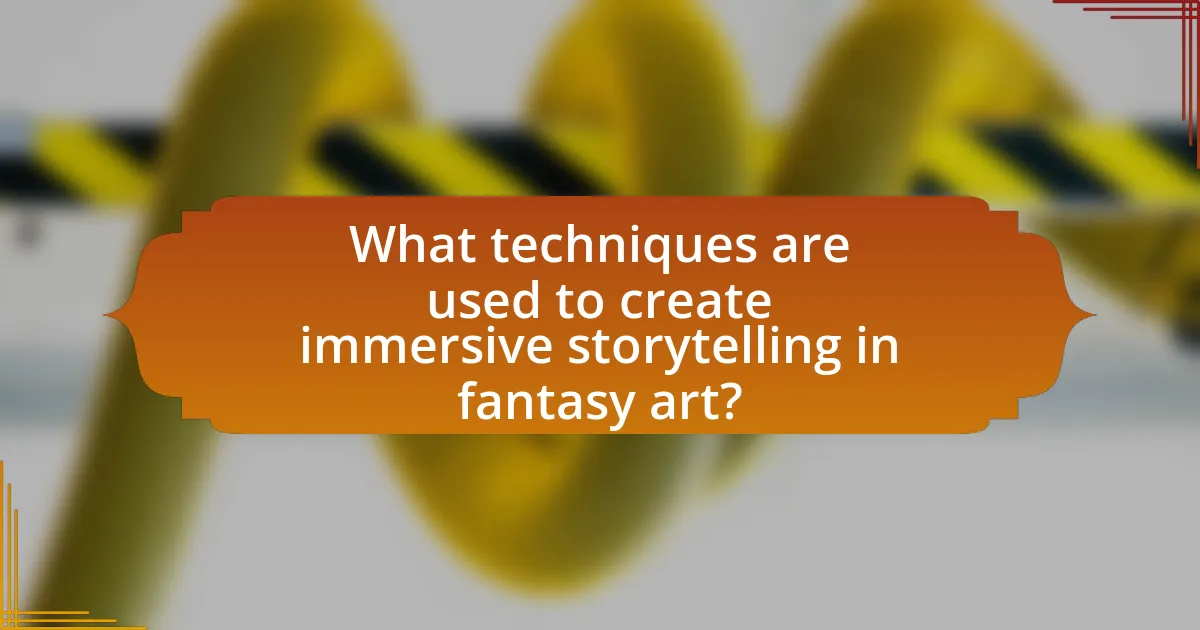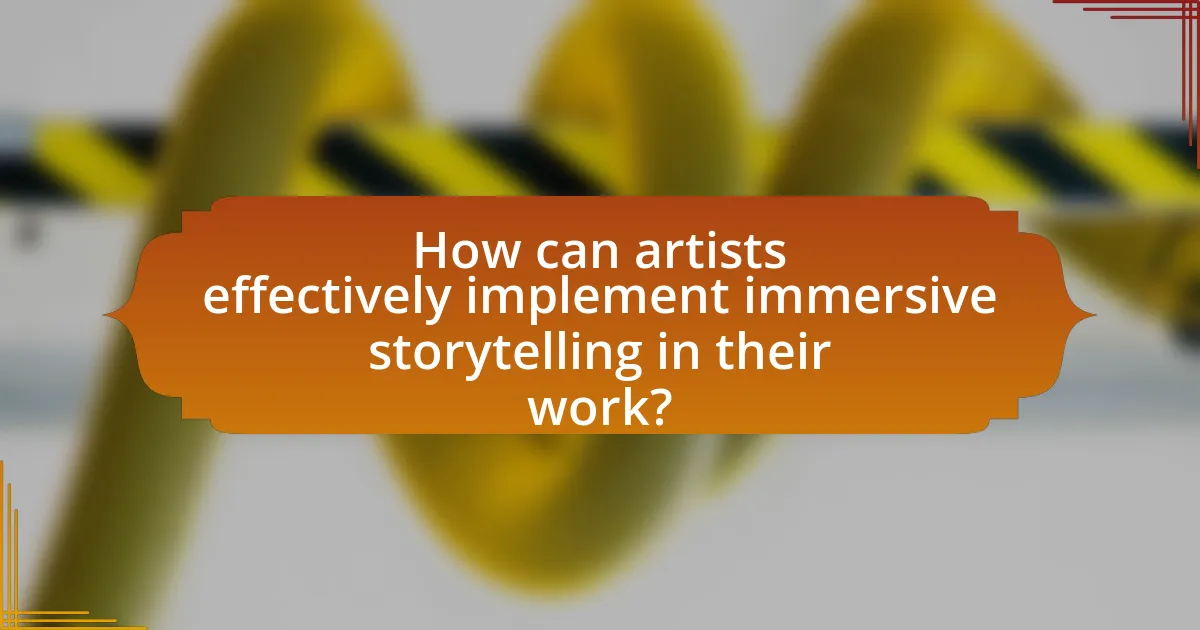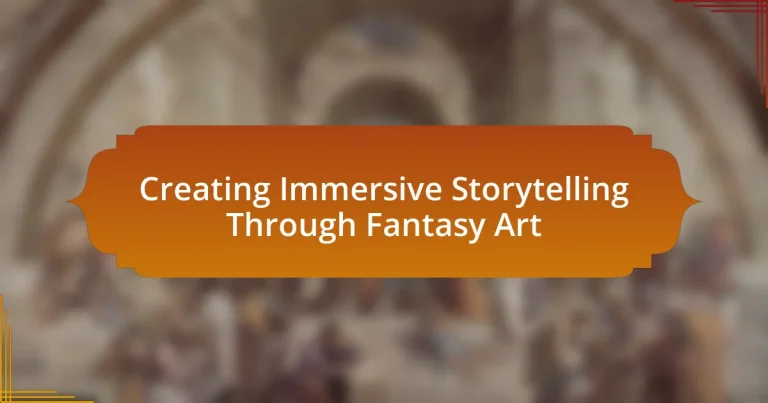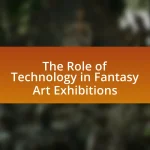Creating immersive storytelling through fantasy art involves a narrative technique that engages viewers by combining detailed artwork, imaginative settings, and character-driven plots. This article explores how immersive storytelling enhances emotional connections, utilizing elements such as vivid world-building, relatable characters, and sensory details to create multi-dimensional experiences. It also examines the psychological effects of color and composition, the role of characters and settings, and best practices for artists to effectively implement these techniques in their work. Additionally, the article addresses common challenges artists face and offers practical tips for maintaining audience engagement throughout the artwork.

What is Immersive Storytelling in Fantasy Art?
Immersive storytelling in fantasy art is a narrative technique that engages viewers by creating a rich, multi-dimensional experience through visual elements. This approach combines detailed artwork, imaginative settings, and character-driven plots to draw the audience into an alternate reality, allowing them to emotionally connect with the story. For instance, artists like Brian Froud and Julie Bell utilize intricate designs and vibrant colors to evoke a sense of wonder and adventure, effectively transporting viewers into fantastical worlds. This method enhances the storytelling by making the art not just a visual representation but an integral part of the narrative experience.
How does immersive storytelling enhance the experience of fantasy art?
Immersive storytelling enhances the experience of fantasy art by creating a deeper emotional connection between the viewer and the artwork. This connection is achieved through narrative elements that engage the audience’s imagination, allowing them to envision themselves within the fantastical worlds depicted. Studies have shown that narratives can significantly increase viewer engagement; for instance, research published in the Journal of Visual Culture indicates that artworks accompanied by stories are remembered more vividly and elicit stronger emotional responses. By integrating immersive storytelling, fantasy art transforms from mere visual representation into a multi-dimensional experience that invites exploration and personal interpretation.
What elements contribute to creating an immersive storytelling experience?
An immersive storytelling experience is created through elements such as vivid world-building, relatable characters, emotional engagement, and sensory details. Vivid world-building establishes a rich, detailed setting that captivates the audience, while relatable characters foster emotional connections, making the story more impactful. Emotional engagement is crucial as it allows the audience to invest in the characters’ journeys, enhancing their overall experience. Sensory details, including visual, auditory, and tactile descriptions, further draw the audience into the narrative, making them feel as though they are part of the story. Research indicates that stories with these elements can significantly enhance audience retention and emotional response, as demonstrated in studies on narrative transportation and engagement in storytelling.
How do visual narratives influence audience engagement in fantasy art?
Visual narratives significantly enhance audience engagement in fantasy art by creating immersive experiences that evoke emotional responses. These narratives utilize visual elements such as color, composition, and character design to convey stories, drawing viewers into fantastical worlds. Research indicates that artworks with strong narrative components can increase viewer retention and emotional investment, as evidenced by studies showing that images with clear storytelling elements are more likely to be remembered and discussed. For instance, a study published in the Journal of Visual Culture found that participants reported higher levels of engagement when viewing art that included narrative cues, demonstrating the effectiveness of visual storytelling in capturing audience attention and fostering a deeper connection with the artwork.
Why is fantasy art a powerful medium for storytelling?
Fantasy art is a powerful medium for storytelling because it visually represents imaginative worlds and characters, allowing for deep emotional engagement. This genre transcends the limitations of traditional narrative forms by creating immersive experiences that stimulate the viewer’s imagination. For instance, the intricate details and vibrant colors in fantasy art can evoke specific emotions and transport audiences to alternate realities, enhancing their connection to the story. Studies have shown that visual storytelling can significantly increase retention and understanding of narrative content, as images can convey complex ideas more efficiently than text alone.
What unique characteristics of fantasy art facilitate storytelling?
Fantasy art facilitates storytelling through its vivid imagery, imaginative worlds, and symbolic representation of themes. The use of vibrant colors and intricate details captures the viewer’s attention, allowing them to immerse themselves in the narrative. Additionally, fantasy art often incorporates fantastical elements, such as mythical creatures and magical landscapes, which evoke emotions and spark the imagination. This visual storytelling technique engages the audience, prompting them to explore the underlying narratives and themes present in the artwork. For example, the works of artists like Frank Frazetta and Brian Froud have been pivotal in shaping the fantasy genre, demonstrating how visual elements can convey complex stories and emotions without the need for words.
How does fantasy art evoke emotions and imagination in viewers?
Fantasy art evokes emotions and imagination in viewers by creating visually rich and immersive worlds that stimulate the mind. The intricate details, vibrant colors, and fantastical elements in fantasy art engage viewers’ senses, prompting them to explore narratives beyond their reality. Research indicates that visual stimuli can trigger emotional responses; for instance, a study published in the journal “Psychology of Aesthetics, Creativity, and the Arts” found that art with high emotional content can enhance viewer engagement and imagination. This connection between visual elements and emotional response allows fantasy art to transport viewers into alternate realities, fostering a sense of wonder and creativity.

What techniques are used to create immersive storytelling in fantasy art?
Techniques used to create immersive storytelling in fantasy art include detailed world-building, character development, and the use of symbolism. Detailed world-building establishes a rich, believable environment that invites viewers to explore its intricacies, often incorporating elements like unique landscapes, architecture, and cultures. Character development is crucial, as well-defined characters with distinct personalities and backstories engage the audience emotionally, making them invested in the narrative. The use of symbolism enhances storytelling by embedding deeper meanings within visual elements, allowing viewers to interpret and connect with the artwork on multiple levels. These techniques collectively foster a sense of immersion, drawing the audience into the fantasy world.
How do color and composition play a role in storytelling?
Color and composition are essential elements in storytelling as they influence the emotional tone and visual narrative of a piece. Color evokes specific feelings; for instance, warm colors like red and orange can create a sense of excitement or urgency, while cool colors like blue and green often convey calmness or sadness. Composition, which refers to the arrangement of visual elements, guides the viewer’s eye and emphasizes key aspects of the story, such as focal points and character interactions. Research indicates that effective use of color and composition can enhance viewer engagement and comprehension, as seen in studies on visual perception and emotional response in art. For example, a well-composed scene with contrasting colors can create tension, while harmonious colors can evoke a sense of peace, directly impacting how the story is perceived and understood.
What are the psychological effects of color choices in fantasy art?
Color choices in fantasy art significantly influence viewers’ emotions and perceptions. For instance, warm colors like red and orange can evoke feelings of excitement or aggression, while cool colors such as blue and green often promote calmness or tranquility. Research indicates that color can affect mood and behavior; for example, a study published in the journal “Color Research and Application” by Andrew Elliot and Markus Maier found that red can enhance performance in competitive situations, while blue can foster creativity. Thus, artists strategically use color to enhance narrative elements and emotional depth in their work, guiding audience reactions and engagement with the fantasy world.
How does composition guide the viewer’s eye and narrative flow?
Composition guides the viewer’s eye and narrative flow by strategically arranging visual elements to create a clear path for observation and understanding. Effective composition utilizes principles such as balance, contrast, and focal points to direct attention, ensuring that the viewer engages with the most important aspects of the artwork first. For instance, the rule of thirds can be employed to position key elements at intersecting points, naturally drawing the viewer’s gaze. Additionally, leading lines can guide the eye through the scene, enhancing the narrative by connecting different elements and creating a sense of movement. This structured approach not only enhances visual appeal but also reinforces the story being told, as evidenced by studies in visual perception that demonstrate how composition influences viewer interpretation and emotional response.
What role do characters and settings play in immersive storytelling?
Characters and settings are fundamental components of immersive storytelling, as they establish emotional connections and contextual frameworks for the narrative. Characters drive the plot through their actions, motivations, and development, allowing audiences to engage with their journeys on a personal level. Settings provide the backdrop that shapes the story’s atmosphere, influencing the characters’ experiences and interactions. For instance, a richly detailed fantasy world can enhance the sense of wonder and adventure, making the story more captivating. Research indicates that well-developed characters and immersive settings significantly enhance audience engagement and emotional investment, as evidenced by studies showing that narratives with strong character development lead to higher levels of empathy and connection among readers.
How can character design enhance narrative depth in fantasy art?
Character design enhances narrative depth in fantasy art by visually conveying a character’s personality, backstory, and motivations. Through specific design elements such as color schemes, clothing, and physical features, artists can communicate complex traits and emotional states, allowing viewers to engage more deeply with the narrative. For instance, a character adorned in dark, tattered clothing may suggest a troubled past or a life of hardship, while vibrant colors and intricate patterns can indicate nobility or joy. This visual storytelling technique is supported by studies in visual perception, which show that people interpret character designs instinctively, leading to immediate emotional connections and a richer understanding of the story being told.
What are the key elements of world-building in fantasy art?
The key elements of world-building in fantasy art include setting, character design, cultural context, and visual storytelling. Setting establishes the environment, such as landscapes, architecture, and climate, which shapes the narrative and influences character interactions. Character design involves creating unique and relatable figures that embody the world’s themes and conflicts, often reflecting the culture and history of the setting. Cultural context encompasses the traditions, languages, and social structures that define the inhabitants of the world, adding depth and realism. Visual storytelling integrates these elements through composition, color, and symbolism, guiding the viewer’s emotional response and engagement with the narrative. These components collectively create a cohesive and immersive experience that draws the audience into the fantasy world.

How can artists effectively implement immersive storytelling in their work?
Artists can effectively implement immersive storytelling in their work by integrating multi-sensory elements that engage the audience on emotional and intellectual levels. This can be achieved through the use of visual narratives, soundscapes, and interactive components that invite viewer participation. For instance, incorporating detailed backgrounds and character expressions in visual art can create a rich context that enhances the story being told. Additionally, utilizing technology such as augmented reality can further immerse the audience, allowing them to experience the narrative in a more dynamic way. Research indicates that immersive storytelling can increase emotional engagement, as evidenced by studies showing that audiences retain information better when it is presented in an interactive format.
What best practices should artists follow for effective storytelling?
Artists should follow the best practices of developing a clear narrative structure, creating relatable characters, and utilizing visual elements to enhance storytelling. A clear narrative structure, including a beginning, middle, and end, helps guide the audience through the story, making it easier to understand and engage with. Relatable characters allow viewers to connect emotionally, as studies show that empathy towards characters increases audience investment in the story. Additionally, visual elements such as color, composition, and symbolism can significantly enhance the narrative, as they provide cues that reinforce the story’s themes and emotions. For instance, research in visual storytelling indicates that color can evoke specific emotions, influencing how the audience perceives the narrative.
How can artists balance visual appeal with narrative clarity?
Artists can balance visual appeal with narrative clarity by employing a cohesive visual language that enhances storytelling elements. This involves using color, composition, and symbolism strategically to guide the viewer’s understanding of the narrative. For instance, a well-placed focal point can draw attention to key story elements, while color palettes can evoke specific emotions that align with the narrative’s tone. Research indicates that visual storytelling techniques, such as the use of visual hierarchy and contrast, significantly improve audience engagement and comprehension. By integrating these techniques, artists can create works that are both aesthetically pleasing and narratively rich, ensuring that the visual elements support rather than overshadow the story being told.
What tools and resources can assist artists in creating immersive fantasy art?
Digital painting software such as Adobe Photoshop and Corel Painter are essential tools for artists creating immersive fantasy art, as they provide advanced features for illustration and texture creation. Additionally, 3D modeling software like Blender and ZBrush allows artists to design intricate characters and environments, enhancing the depth of their artwork. Resources such as online tutorials, platforms like ArtStation for inspiration, and community forums for feedback further support artists in refining their skills and techniques. These tools and resources collectively enable artists to produce detailed and engaging fantasy art that captivates audiences.
What common challenges do artists face in immersive storytelling?
Artists face several common challenges in immersive storytelling, including balancing narrative depth with audience engagement. This challenge arises because artists must create compelling stories that captivate audiences while ensuring that the immersive elements do not overshadow the narrative. Additionally, technical limitations can hinder the realization of artistic visions, as artists often grapple with the constraints of technology and tools available for creating immersive experiences. Furthermore, achieving emotional resonance is crucial; artists need to evoke feelings that connect the audience to the story, which can be difficult in a medium that relies heavily on visual and interactive elements. These challenges are supported by industry observations, such as the need for artists to continuously adapt to evolving technologies and audience expectations in the realm of immersive storytelling.
How can artists overcome creative blocks when developing narratives?
Artists can overcome creative blocks when developing narratives by employing techniques such as free writing, brainstorming, and engaging in collaborative discussions. Free writing allows artists to express thoughts without self-censorship, often leading to unexpected ideas and connections. Brainstorming sessions can generate a multitude of concepts, providing a diverse pool of inspiration to draw from. Collaborative discussions with peers can introduce new perspectives and insights, fostering creativity. Research indicates that engaging in these practices can significantly enhance creative output, as demonstrated in studies on group dynamics and creativity, which show that collaboration often leads to more innovative solutions.
What strategies can be employed to maintain audience engagement throughout the artwork?
To maintain audience engagement throughout the artwork, artists can employ interactive elements, narrative depth, and visual variety. Interactive elements, such as augmented reality features or viewer participation, invite audiences to engage actively with the artwork, enhancing their connection. Narrative depth can be achieved by incorporating storytelling techniques that evoke emotions and provoke thought, making the artwork more relatable and memorable. Visual variety, including contrasting colors, textures, and dynamic compositions, captures attention and encourages viewers to explore the artwork more thoroughly. Research indicates that artworks with these strategies can increase viewer retention and emotional response, as evidenced by studies showing that interactive and narrative-driven art experiences lead to higher levels of audience satisfaction and engagement.
What are some practical tips for creating immersive storytelling through fantasy art?
To create immersive storytelling through fantasy art, artists should focus on developing rich, detailed worlds that engage the viewer’s imagination. This can be achieved by incorporating elements such as intricate backgrounds, diverse character designs, and symbolic imagery that conveys deeper narratives. For instance, using color palettes that evoke specific emotions can enhance the storytelling aspect; studies show that colors can influence mood and perception, making them powerful tools in visual storytelling. Additionally, artists should consider the use of perspective and composition to guide the viewer’s eye and create a sense of depth, which can draw the audience into the scene. By combining these techniques, artists can effectively craft a narrative that resonates with viewers and invites them to explore the fantasy world presented.


